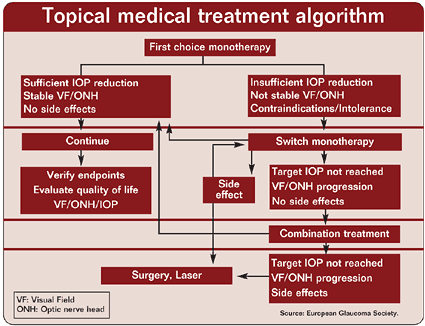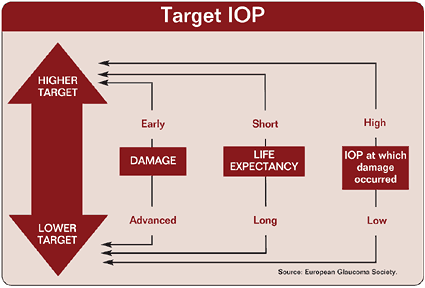EGS issues updated glaucoma guidelines
A member of the committee that drafted the revision says lower target pressures are part of the message to physicians.
COPENHAGEN — The European Glaucoma Society has issued amended guidelines for the management of primary open-angle glaucoma. For the general ophthalmologist and physician, these updated guidelines provide an overview on the latest outcome evidence, explaining revised practice recommendations for managing patients with glaucoma or ocular hypertension. This article reviews some of the important considerations outlined in the newly revised document.
Primary open-angle glaucoma is a chronic, progressive bilateral optic neuropathy. The treatment goal is to maintain the patient’s quality of life by preserving visual function and help prevent or delay significant functional impairment. Intraocular pressure is still the main risk factor for the development or progression of glaucoma. Moreover, the lowering of IOP in glaucoma is the only proven approach to preserving visual function.
While the overall treatment goal remains unchanged in terms of preservation of vision and quality of life, the means of reaching that goal have changed. Lower target pressures are now advised in patients who experience rapid progression or who have advanced sight-threatening damage. Consequently, the previous general treatment goal of a pressure level of 21 mm Hg or less is now considered obsolete.
Single agent first
The available agents that are licensed for first-line treatment of glaucoma or ocular hypertension vary country by country. First-line licensed treatment defines a drug that is approved by the controlling regulatory body for initial pressure lowering. In Europe, this includes timolol and latanoprost.
The revised guidelines no longer recommend ophthalmic beta-blockers as the preferred first-line therapy. Many newer antiglaucoma medications have been introduced, and evidence suggests that the 20% to 25% pressure lowering seen with ophthalmic beta-blockers may not always be adequate.
However, the EGS has deliberately sought to avoid a prescriptive approach and does not endorse any specific antiglaucoma medication as initial therapy. Instead, the guidelines state that the medication chosen as the initial monotherapy should be one that is well-tolerated, safe, and has a good pressure-lowering effect. In choosing a medical treatment for glaucoma, the mode of action, side effects and contraindications of each medication must be considered, balancing proven long-term efficacy with systemic and ocular safety.
Other agents, principally the prostaglandin derivatives, have in many instances superseded topical beta-blockers as the preferred initial treatment for glaucoma and ocular hypertension. Other available antiglaucoma medications include adrenergic agonists, topical carbonic anhydrase inhibitors, parasympathomimetics and combined drug preparations.
Whatever the initial medication, it is advisable that a therapeutic trial with a single agent be used if possible to determine efficacy and response. Topical treatment should be started in one eye at a time when practical. The difference in IOP between the treated and untreated eyes will give an idea of the effect.
|
|
Treatment algorithm
Generally speaking, if the starting treatment has no effect, or if tachyphylaxis occurs, then physicians are advised to change the initial monotherapy agent rather than to add another drug. Insufficient pressure reduction is defined as a nonresponse, that is, the patient’s IOP after treatment has fallen by less than 15% from the pretreatment baseline.
Nonresponse may also be defined by progression of visual field or optic nerve head change. If after switching to a replacement monotherapy the physician is still not satisfied with the pressure-lowering efficacy, or if progression is detected, then combination drug preparations may provide additional benefit with an incremental pressure-lowering effect.
Many patients may nonetheless respond to initial treatment but do not reach the target IOP, or revised target IOP, on one medication alone. For the many patients inadequately controlled on monotherapy, adjunctive therapy may be considered, remembering that it may be beneficial to use therapies with complementary modes of action.
When physicians decide to add medications, they are advised to consider the benefits of combined drug preparations. These preparations are generally preferable to two separate instillations of the same agents, due to improved compliance, reduced dosing schedule and reduced preservatives. Also, the concentration of drug and frequency of dosing should always be kept to a minimum.
Target IOP
We should not treat all patients in the same manner, given marked individual variations in treatment response, and, further, variations in the rate of cell loss and functional decay. The principle of intraocular target pressure is highly useful in routine clinical practice, helping tailor treatment to the needs, conditions and preferences of the individual patient.
The IOP target is defined as the mean IOP obtained with treatment that prevents or delays further glaucomatous damage. The target IOP will vary for each patient depending on presenting IOP, the degree of existing glaucoma damage at presentation, the extent of central visual field loss and also the rate of glaucomatous progression. Age, life expectancy and presence of other risk factors will also help determine the most appropriate initial target IOP for the patient.
|
|
Evidence from five major randomized multicenter clinical studies tell us that we must achieve low target pressures to keep vision stable. These recent clinical trials provide fresh guidance for choosing target pressures appropriate for patients with mild initial glaucoma, advanced glaucoma, normal-tension glaucoma and ocular hypertension.
The trials show that, when treatment is indicated, the best benefit is achieved when the pressure is reduced 30% or more. While there is no single IOP level that is safe for every patient, physicians are advised to aim to lower IOP by at least 30% from baseline as the initial target.
Furthermore, the magnitude of initial IOP reduction is a major factor in influencing visual outcome in glaucoma. Data from both the Ocular Hypertension Treatment Study and the Early Manifest Glaucoma Trial indicate that for each 1 mm Hg of pressure reduction, the risk of progression or conversion is reduced by 10%; equally, this means that each pressure rise of just 1 mm Hg increases the risk of progression by 10% or more.
An average 25% pressure lowering in the Early Manifest Glaucoma Trial halved the progression risk in newly detected patients with early glaucoma.
The size of the pressure reduction from pretreatment to the first follow-up visit is an important predictive factor in securing beneficial response in the long term. Physicians are advised to aim for an immediate reduction to the target pressure, rather than adopt an incremental approach.
Closer follow-up needed
In clinical practice, careful follow-up with frequent visits in the first few years is advised to assess treatment response, including tolerability of therapy and disease progression. Close monitoring in the early stages helps to determine the rate of glaucomatous progression, identify those who are stable and those who require a reassessment of treatment strategy. Follow-up should include examination and documentation of visual field status, optic nerve head morphology and the retinal nerve fiber layer where possible. It is not adequate solely to rely on visual field assessment, especially in cases of ocular hypertension.
The guidelines recommend that treatment of ocular hypertension may be indicated in patients with moderate or high risk of progression, for example in patients with thin corneas. The Ocular Hypertension Treatment Study confirmed unexpectedly that central corneal thickness is a major predictive factor for glaucoma conversion. Other significant predictors of glaucoma were also identified, including older age, large vertical or horizontal cup-disc ratio, higher IOP, greater Humphrey visual field pattern standard deviation and heart disease.
Physicians now have better evidence about the associated risk factors, enabling them to better identify ocular hypertensive individuals who might benefit from hypotensive therapy. The information now available makes it easier for physicians to find ocular hypertensive patients that need treatment, avoiding much of the guesswork of past practice.
Early aggressive therapy
Early aggressive treatment in glaucoma (pressure reductions of more than 35%) may be indicated when presenting pressure is high, there is advanced glaucoma at presentation, there is an advanced rate of progression, central vision loss is expected within the patient’s lifetime or there are additional risk factors, such as advanced glaucoma in the second eye.
Normally, aggressive treatment would not mean monotherapy with a single antiglaucoma medication but would necessitate either adjunctive therapy with combined drug preparations, argon laser trabeculoplasty or drainage surgery. Trabeculectomy with antimetabolites should be considered in cases of rapid progression or in advanced glaucoma in younger patients.
Conclusion
Response to medical treatment for glaucoma is determined by several variables in addition to baseline IOP reduction. These include the degree of progression or stability of the visual field, changes in optic nerve head morphology and overall tolerability and convenience of the prescribed therapy. The effectiveness of medical therapy depends ultimately on the ability of the patient to tolerate it and comply with the treatment schedule.
The goal of treating glaucoma is to maintain the patient’s quality of life at a sustainable cost. The cost of treatment in terms of inconvenience and side effects, as well as financial implications for the individual and society, requires careful evaluation. Quality of life is closely linked to visual function. Therefore the choice of medical therapy for glaucoma and ocular hypertension must take into account quality of life, cost and compliance.
For Your Information:
- John Thygesen, MD, is an associate professor in the department of ophthalmology of the Rigshospitalet, University Hospital of Copenhagen, Denmark, and director of the glaucoma and traumatology services. He is a member of the Executive Committee and the Educational Committee of the European Glaucoma Society. He can be reached at University Glaucoma Clinic, Rigshospitalet, DK-2100 Copenhagen, Denmark; +(45) 35 45 31 77; fax: +(45) 35 45 32 70; email: jthygesen@rh.dk.
References:
- Kass MA, Heuer DK, et al. The Ocular Hypertension Treatment Study: A randomized trial determines that topical ocular hypotensive medication delays or prevents the onset of primary open-angle glaucoma. Arch Ophthalmol. 2002;120:701-713.
- Heijl A, Leske C, et al. Reduction of intraocular pressure and glaucoma progression. Results from the Early Manifest Glaucoma Trial. Arch Ophthalmol. 2002;120:1268-1279.
- Leske C, Heijl A, et al. Factors for glaucoma progression and the effect of treatment. Arch Ophthalmol. 2003;121:48-56.
- Collaborative Normal-Tension Glaucoma Study Group. Comparison of glaucomatous progression between untreated patients with normal-tension glaucoma and patients with therapeutically reduced intraocular pressure. Am J Ophthalmol. 1998;126: 487-497.
- Lichter PR, Musch DC, et al; CIGTS Study Group. Interim clinical outcomes in the Collaborative Initial Glaucoma Treatment Study comparing initial treatment randomized to medications or surgery. Ophthalmology. 2001;108:1943-1953.
- The AGIS Investigators. The advanced glaucoma intervention study (AGIS): 7. The relationship between control of intraocular pressure and visual field deterioration. Am J Ophthalmol. 2000;130:429-440.


